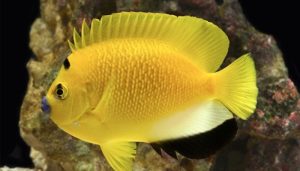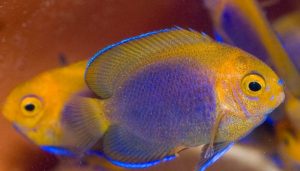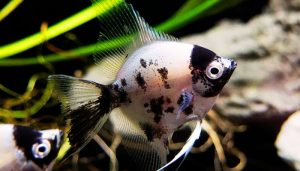What do nerite snail eggs look like? Nerite snails are a popular addition to many aquariums thanks to their ability to clean algae and debris. While they are generally low-maintenance, one aspect of their reproduction can challenge some aquarium owners – their eggs.
Nerite snails are prolific egg layers, and seeing numerous small white or translucent eggs can cause overpopulation concerns.
Understanding what nerite snail eggs look like can help aquarium hobbyists prevent their tanks from becoming overrun with snails.
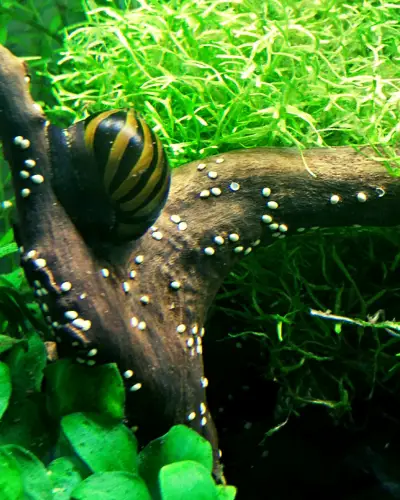
Nerite snail eggs are typically round and range from a pinhead to a small pebble. They are firmly allocated on hard surfaces within the fish tank, such as rocks, glass, and tank plants. The eggs are often clustered together in groups, resembling tiny pearls.
While their appearance might be aesthetically pleasing to some, others may find the presence of eggs unwanted due to the rapid reproduction of nerite snails.
In this article, we will look closer at the characteristics of nerite snail eggs, why they can lead to overpopulation, and strategies to prevent and control their numbers in your aquarium.
So, if you are a proud owner of nerite snails or are considering adding them to your aquarium, stay tuned to learn more about their eggs and how to manage their population effectively.
Table of Contents
ToggleWhat Do Nerite Snail Eggs Look Like in Aquariums?
When it comes to nerite snail eggs in an aquarium, they can be pretty fascinating to observe. These small, round nerite eggs can often be found attached to various surfaces such as driftwood, aquarium plants, or even the glass walls of the tank.
The female snails lay the eggs and will hatch into baby snails when suitable. The water temperature and water parameters are essential factors for successful reproduction.
Interestingly, nerite snails are male and female, so having both genders in the tank is unnecessary for them to reproduce. However, it is common for female snails to lay eggs even without the presence of a male.
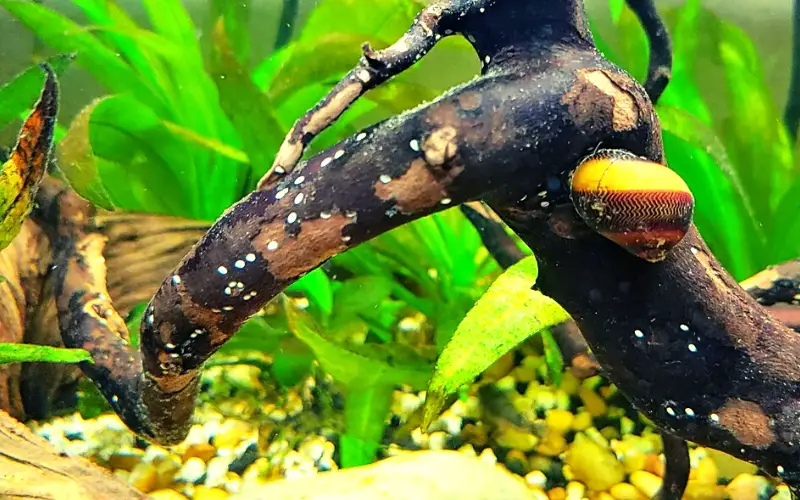
These nerite eggs are tiny, measuring only a few millimeters in size. They are usually seen as little white or white dots clustered together. It is important to note that these eggs are unsuitable for hatching in freshwater tanks as they require saltwater for successful development.
Therefore, removing the eggs from the tank is recommended if you want to avoid a nerite snail population explosion. However, if you are interested in breeding nerite snails, you can provide saltwater conditions for the eggs to hatch.
One of the best things about nerite snails is that they are excellent algae eaters. They will happily graze on various types of freshwater and saltwater algae, helping keep your tank clean. Additionally, they are not known to reproduce rapidly and overpopulate the tank like some other freshwater aquarium snails.
Cherry shrimp and amano shrimps can also help control the snail population by preying on the babies and eating the eggs. Therefore, if you have a well-balanced ecosystem with different types of snails, shrimps, and fish, you can enjoy the benefits of these mesmerizing creatures without worrying about an explosion in the snail population.
Can Aquarium Snails Lay Eggs Without Mating?
Can aquarium snails lay eggs without mating? The answer is yes; snails may lay eggs even without a partner. If you have adult nerite snails in your fish tank, you may wake up one day to find eggs everywhere.
Nerite snail tank mates or zebra snails can lay these tiny eggs in the aquarium water. The hatching of nerite snail eggs is interesting as the eggs appear either attached to driftwood or on the sides of the fish tank.
Although many eggs may be laid, they only occasionally hatch in freshwater. The eggs will only hatch if the water quality in the tank is good or if no male and female nerite snails are present.
To prevent overpopulation, controlling the green spot algae using a sharp algae scraper and a water filter is recommended. Breeding nerite snail algae can be fascinating, but it’s essential to have the quarantine tank ready in case the eggs need to be separated.
Can Nerite Snails Lay Eggs Without a Male?
Unfortunately, Nerite snails cannot lay eggs that will hatch without a male present. Nerite snails are not hermaphrodites, meaning they have distinct sexes (male and female). Only the females lay eggs, which need fertilization from a male for development.
Here’s what you need to know:
- Sexual reproduction: unlike many other freshwater snails, Nerite snails rely on sexual reproduction for offspring. This means both a male and female are required for egg development.
- Egg laying: Female Nerite snails can lay eggs regardless of the presence of a male. These eggs, however, remain infertile and will not hatch.
- Egg appearance: Nerite snail eggs are small, white capsules on hard surfaces like rocks or aquarium glass. While infertile eggs might appear similar to fertilized ones initially, they eventually turn opaque and fail to develop further.
While finding a male and female Nerite pair can be challenging, several factors can encourage egg laying even without successful fertilization:
- Healthy environment: Good water quality, ample algae growth, and sufficient calcium intake can trigger egg laying regardless of mating.
- Internal storage: Female Nerite snails can store sperm for some time, potentially leading to some fertilized eggs even with a limited mating period.
Remember, even if you see eggs in your tank, their viability depends on the presence of a male Nerite snail. If you want to control their population, removing one or both snails or physically eliminating the eggs might be necessary.
Will Nerites Eggs Hatch in Freshwater Aquarium?
Observing nerites laying their eggs for the first time in a freshwater aquarium is interesting. These snails release their eggs into the water, usually attaching them to surfaces like plants, glass, or driftwood.
The eggs appear as small white ovals, which can be numerous throughout the tank. While nerite snails are one of the best algae eaters, their eggs can indicate poor water quality, especially if the tank size is small and water changes are infrequent.
Unlike some snails, nerites need brackish water to reproduce, so the eggs will not hatch in a freshwater aquarium. If the eggs become an issue, you can manually remove them or introduce other tank inhabitants, like red cherry shrimp, as they may eat them.
However, be cautious, as nerite eggs can be hard to remove and sometimes require scraping or a razor blade.
How Do You Prevent Hatching the Eggs of a Nerite Snail?
How do you prevent Nerite snail eggs? It’s important to understand that Nerite snails cannot hatch their eggs in freshwater aquariums. While they lay fertile eggs, these eggs require a specific brackish water environment with different salinity levels to develop into larvae successfully and eventually mature snails. The eggs will form a thin membrane in freshwater but fail to hatch.
Therefore, you don’t need to take any specific action to prevent hatching in your freshwater aquarium. The eggs remain harmless and decompose eventually. However, if you find the egg clusters unsightly, here are some options:
Manual Snail Egg Removal:
- Use a thin card, stainless steel spoon, or razor blade (carefully) to scrape the eggs off surfaces like glass or decorations.
- If eggs are on plants, consider temporarily removing the affected leaves or quarantining the plant briefly in a separate container.
- Dispose of removed eggs by crushing them or submerging them in vinegar.
Preventative Measures:
- Quarantine new plants: This helps prevent the introduction of unwanted snail eggs along with new vegetation.
- Choose male Nerite snails: While sexing Nerites is challenging, some aquatics stores might attempt to differentiate based on subtle shell features. However, success is only sometimes guaranteed.
- Maintain healthy tank parameters: Provide a well-maintained environment with good water quality and suitable food sources for your Nerites. A balanced ecosystem might discourage excessive egg-laying.
Remember, Nerite snails are generally beneficial for planted aquariums due to their algae-eating habits. Consider if their egg-laying indeed poses a problem before taking any action.
Nerite Snails are Great Algae Eating Machines
Nerite snails are significant algae-eating machines. These tiny creatures can make a big difference in keeping your aquarium clean and free from excessive algae growth.
When you introduce the snails into the water, they quickly devour algae on the glass, plants, and decorations. They can even eat the algae that other fish won’t touch.
One of the reasons why nerite snails are so effective at controlling algae is because they reproduce quickly. Each female snail can lay hundreds of eggs inside the tank, usually on the glass or driftwood.
However, these eggs won’t hatch in freshwater, so you don’t have to worry about your tank being overrun with baby snails.
If you add Nerite snails to your tank, it’s best to start with two for every gallon of tank space. Remember that nerite snails are marine creatures, so if you have a large tank, you may need to add marine salt to the water to create a suitable habitat.
How Do You Safely Remove Nerite Snail Eggs from Your Aquarium?
Removing snail eggs from your aquarium can be tricky, but you can try a few safe methods depending on where the eggs are located and your desired outcome. Here are some options:
Manual Removal:
- For glass eggs: This is the simplest option. Use a thin card, plastic scraper, or even your fingernail to scrape the eggs off the glass gently. Be careful not to scratch the glass or harm other tank inhabitants.
- For eggs on rocks or decorations: Remove the affected rock or decoration and manually remove the eggs from driftwood with a toothbrush, soft cloth, or your fingers. Rinse the item thoroughly before returning it to the tank.
- For stubborn eggs: You can use a razor blade (be very careful!), but only as a last resort and with extreme caution.
Why Avoid Using Aquarium Salt With Nerite Snails?
Aquarium salt should be avoided when keeping nerite snails in your tank. The main reason is that nerite snails do not tolerate high salt levels. Adding aquarium salt to the tank can cause stress and harm these delicate creatures.
Additionally, aquarium salt can negatively impact any eggs the nerite snails may lay in your tank. Adult snails lay their eggs on various surfaces, such as driftwood. When aquarium salt is present, it can prevent the eggs from hatching and developing correctly.
Moreover, introducing aquarium salt into the tank water can increase ammonia, which is toxic to nerite snails. Therefore, providing a salt-free environment for these snails to reproduce and live out their lives is best.
If you accidentally use aquarium salt, removing it from the tank as soon as possible is essential to prevent any harm to the nerite snails. Look out for little white dots, which indicate the presence of nerite snail eggs, and ensure they are not affected by aquarium salt.
Commonly Asked Questions about What Do Nerite Snails Eggs Look Like in Freshwater Tanks (FAQs)
What Should You Do With Mystery Snail Eggs?
Mystery snail eggs should be left undisturbed in the aquarium or transferred to a separate container until they hatch.
How do you make brackish water for Nerite snail eggs?
Mix freshwater and marine salt mix to achieve a salinity of around 1.005-1.010 specific gravity to make brackish water for Nerite eggs. Monitor and maintain proper salinity levels throughout incubation.
Will Nerite snail eggs hatch in fresh water?
Unfortunately, Nerite snail eggs won’t hatch in freshwater. They require brackish or saltwater for successful development. So, while you might see eggs, they won’t become little snail friends in your freshwater tank.
Will a single female Nerite snail lay eggs?
A single female Nerite might still lay eggs, but they won’t hatch in freshwater! These eggs usually need a male for fertilization but remain unviable as the larvae require brackish/saltwater.
Will shrimp eat nerite snail eggs?
Some shrimp species, like Amano shrimp, might nibble on Snail eggs but can’t hatch in freshwater tanks! So, while shrimp may “clean up” the eggs, no baby snails will appear.
Do Nerite snails lay eggs in freshwater?
Nerite snails can lay eggs in freshwater, but they won’t hatch. The larvae need brackish or saltwater, so while you might see “mystery seeds,” no baby snails will surprise you!
How do Nerite snails have babies?
Nerite snails reproduce by laying eggs in freshwater. The eggs hatch into larvae, which then develop into snail babies.
Will Nerite snails breed in fresh water?
No, Nerite snails will not breed in freshwater. They require brackish or marine water conditions to reproduce and hatch their eggs successfully.
Conclusion
So, what do nerite snails eggs look like? When it comes to the appearance of nerite eggs, they are incredibly small and dark in color. They usually range in size from 1-3mm and can be found attached to various surfaces in the tank, such as plants, rocks, or driftwood. The eggs are oval-shaped and have a hard shell, which helps to protect them from predators and harsh environmental conditions. The color of the eggs can vary depending on the species of nerite snail, but they are typically brown, black, or dark green.
It’s important to note that nerite snails cannot reproduce in freshwater environments, so if you have two nerite snails in a gallon tank, you won’t have to worry about dealing with a sudden influx of eggs. Understanding What do nerite snail eggs look like will help. If you find eggs in your tank, they can easily be removed by scraping them off using a credit card or similar object.
You might also like
- Zebra Nerite Snail 101: The Ultimate Beginners Care Guide
- Nerite Snails Saltwater Tank 101: (A Comprehensive Guide)
- What Eats Nerite Snail Eggs: (3 Effective Fish Species)
- How Often Do Nerite Snails Lay Eggs: (A Comprehensive Guide)
- Preventing Nerite Snail Eggs in Your Aquarium: 3 Secret Ways
- Snail Eggs in Fish Tank 101: (Identifying & Caring for Them)
- Do Nerite Snails Eat Plants in Aquarium (The Shocking Fact)
- Freshwater Aquarium Snail Eggs on Glass: What You Should Do?
- Identifying Freshwater Snail Pond Snail Eggs in Aquarium: Comprehensive Guide
- What Do Snails Eggs Look Like in an Aquarium: (Ultimate Guide)


